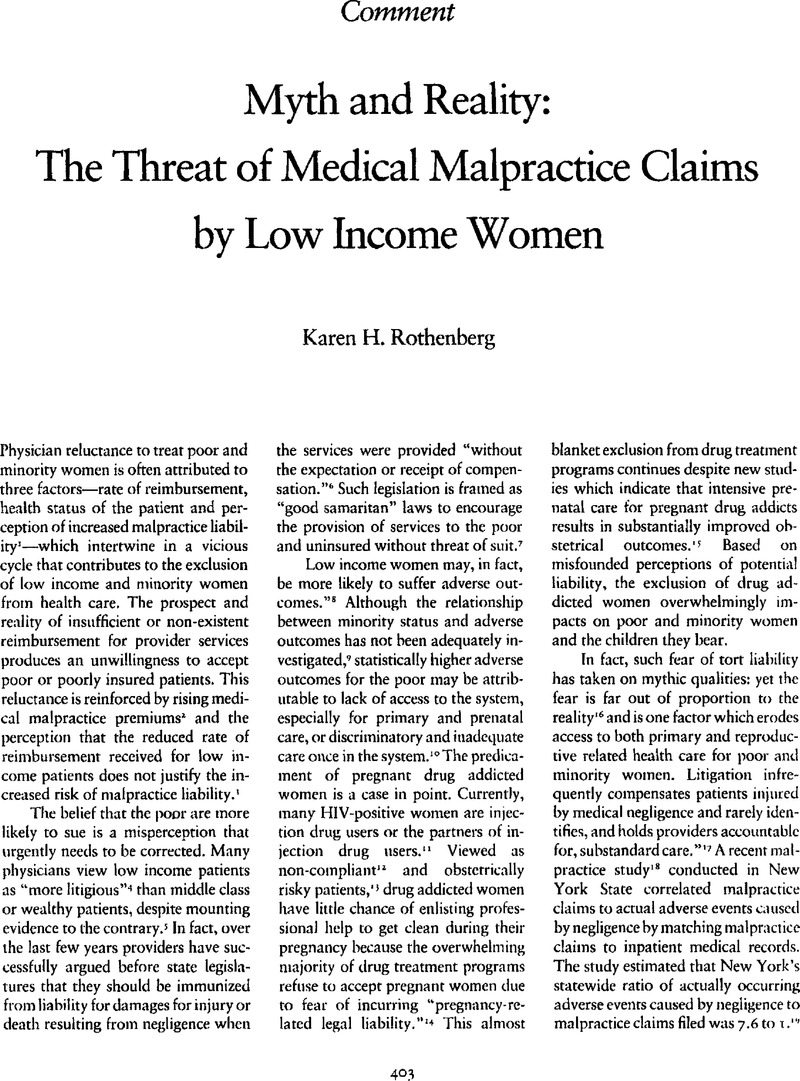No CrossRef data available.
Article contents
Myth and Reality: The Threat of Medical Malpractice Claims by Low Income Women
Published online by Cambridge University Press: 29 April 2021
Abstract
An abstract is not available for this content so a preview has been provided. Please use the Get access link above for information on how to access this content.

- Type
- Comment
- Information
- Copyright
- Copyright © American Society of Law, Medicine and Ethics 1992
References
Mussman, Mary G., Zawistowich, Lu, Weisman, Carol S., Malitz, Faye E. and Morelock, Laura, “Medical Malpractice Claims Filed by Medicaid and Non-Medicaid Recipients in Maryland,” 265 JAMA 2992 (June 12, 1991).Google Scholar
Perkins, Jan and Stoll, Kathleen, “Medical Malpractice: A Crisis for Poor Woman,” Clearinghouse Review 1277 (Feb. 1987).Google Scholar
Supra note 1 at 2992. (“The cost of malpractice insurance is thought to deter physicians from participating because Medicaid payment is insufficient to compensate for rising premiums…”).Google Scholar
Hilfiker, David, “Are Poor Patients More Likely to Sue for Malpractice?” 262 JAMA 1391–1392 (September 8, 1989) and Perkins supra note 2 at 1278–79.Google Scholar
Emphasis added. § 51-1-29.1 of Georgia Code provides:Google ScholarGoogle ScholarGoogle ScholarGoogle Scholar
See Rothenberg, Karen H., “Who Cares? The Evolution of the Legal Duty to Provide Emergency Care,” 26 Houston L. Rev. 21 (1989).Google Scholar
Supra note 1 at 1278. (“Pregnant women on Medicaid or with no insurance are included in most practitioners' definitions of “high risk,” because these women more often receive no prenatal care and exhibit other indications of pregnancy complications such as inadequate diet and high stress.”) and Supra note 1 at 1991.Google Scholar
Brennan, Troyen, Hebert, Liesi E., Laird, Nan M., Lawthers, Ann, Thorpe, Kenneth E., Leape, Lucian L., Russell Localio, A., Lipsitz, Stuart R., Newhouse, Joseph P., Weiler, Paul C., Hiatt, Howard H., “Hospital Characteristics Associated with Adverse Events and Substandard Care,” 265 JAMA 3265 (June 16, 1991).Google Scholar
CDC, “Update: Acquired Immunodeficiency Syndrome—United States, 1981–1990,” 40(2) MMWR 358 (June 7, 1991). (“A history of IV-drug abuse was reported by 2329 (47.6%) women with AIDS. Heterosexual contact with a man infected with HIV or at high risk for HIV infection accounted for 1657 (33.9%) cases among women; 64.1% of these male sexual partners were IV-drug users.”)Google Scholar
Levine, Carole, “Women and HIV/AIDS Research: The Barriers to Equity,” 14 Evaluation Review 447, 449 (1990).Google Scholar
McNulty, Molly, “Combating Pregnancy Discrimination in Access to Substance Abuse Treatment for Low-Income Women,” Clearinghouse Review 21, 22 (May 1989). (“Most drug treatment programs categorically do not admit pregnant addicts, because clinics lack obstetrical expertise, because a pregnant addict is considered “high-risk” and drains away a disproportionate share of treatment resources, or because they fear obstetrical malpractice suits. Likewise, prenatal care centers often turn away pregnant women who are addicts, because they lack drug treatment capacity, or because they wish to avoid treating high-risk patients.”)Google Scholar
See e.g., Randall, Teri, “Intensive Prenatal Care May Deliver Healthy Babies to Pregnant Drug Abusers,” 265 JAMA 2773–2774 (June 5, 1991).CrossRefGoogle Scholar
A survey of New York physicians in 1989 found that “on average, physicians estimate that 19.5 out of one hundred of their colleagues will be sued in a given year, approximately three times the actual rate, with significant differences by specialty, location, and suit history …. High risk specialties (obstetrics, orthopedics, and neurosurgery) had a perceived risk of being sued that was almost three times that of low-risk specialties (internal medicine and associated subspecialties) and 76 percent higher than the overall average perceived risk of 19.5 suits per one hundred physicians.” “Physicians' Perceptions of the Risk of Being Sued,” Lawthers, A.G., Localio, A.R., Laird, N.M. et al., Journal of Health Politics, Policy and Law 17:3, 1992.CrossRefGoogle Scholar
Localio, A.R., Lawthers, A.G., Brennan, T.A., Laird, N.M., Herbert, L.E., Peterson, L.M., Newhouse, J.P., Weiler, P.C., Hiatt, H.H., “Relation Between Malpractice Claims and Adverse Events Due to Negligence: Results of the Harvard Medical Practice Study III,” 325(4) N. Engl. J. Med. 245–51, 250 (July 25, 1991).Google ScholarGoogle Scholar
Id. at 249.Google Scholar
Empirical evidence suggests providers can reduce actual malpractice claims by all socioeconomic groups by improving communications with patients. Hickson, Gerald, Clayton, Ellen Wright, Githens, Penney, and Sloan, Frank, “Factors that Prompted Families to File Medical Malpractice Claims Following Perinatal Injuries,” 267 JAMA 1359–1363 (March 11, 1992). A recent study, which surveyed 127 Floridian families who had filed claims for birth-related injuries, examined the reasons why families filed lawsuits. The reasons cited are illuminating: While 24% filed to obtain funds for long-term care, 20% filed when they realized the child had “no future”; 19% wanted to deter future incidents of malpractice or obtain revenge on the physician; 33% filed because someone, often another doctor, advised them to file, (or alternatively, the families interpreted subsequent treating physician comments as recognition of an injury or advice to sue); 24% filed because their physician was not honest about the circumstances of the injury; and 20% filed because it was the only way the families could determine what caused the injury. Families believed physicians failed to recognize fetal distress (53% of sample), manage fetal distress properly (57%), or perform a caesarean section (33%) or that physicians were unavailable when needed (29%).Google Scholar
Supra note 2, at 1280.Google Scholar
Supra note 5 at 1391–1391. (“The perception that poor patients sue more for medical malpractice is a damaging myth.”)Google Scholar
Id; See also supra note 2, at 1180.Google Scholar
Supra note 9.Google Scholar
In contrast, medical malpractice defense work is generally conducted on a hourly charge basis, with the attorney recovering regardless of the outcome.Google Scholar
Of course, this conclusion may change in the context, for example, of women and the AIDS epidemic. When HIV begins to affect increasing numbers of white, middle class women, the risk calculus may be altered. This group of women may be more likely to recognize the occurrence of an injury, better able to afford to sue, more likely to have family members able to press the suit, and more likely to recover a larger judgment.Google Scholar


